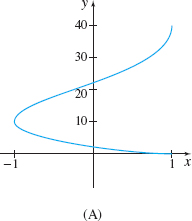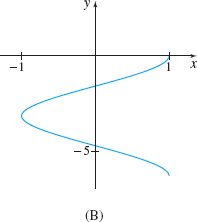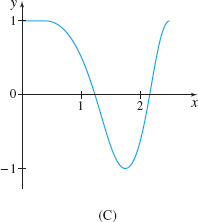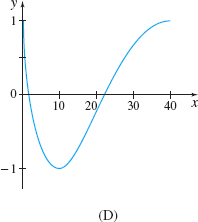11.1 Assess Your Understanding
765
Concepts and Vocabulary
Question
The domain of \(\mathbf{r}(t) =( 4t+1) \mathbf{i}+\sqrt{4-t}\mathbf{j}+\mathbf{k}\) is _______.
Question
True or False A vector function is continuous at a real number \(t_{0}\) if at least one of its component functions is continuous at \(t_{0}\).
Question
True or False To find the derivative of a vector function \(\mathbf{r=r}(t), \) find the derivative of each of its component functions.
Question
True or False The derivative of a dot product is a scalar function.
Question
True or False If \(y=f(t)\) is a differentiable real (scalar) function and \(\mathbf{r=r}(t)\) is a differentiable vector function, then \(\dfrac{d}{dt}\left[ f(t) \mathbf{r}(t) \right] =f^{\prime} (t) \dfrac{d}{dt}\mathbf{r}(t) .\)
Question
If \(\mathbf{u=u}(t)\) and \(\mathbf{v=v}(t)\) are vector functions in space that are differentiable, then \(\dfrac{d}{dt}\left( \mathbf{u} \times \mathbf{v}\right)=\)______.
Skill Building
In Problems 7–14, find the value of each vector function at t.
Question
\(\mathbf{r}(t)=t^{2}\mathbf{i}-2t\mathbf{j}\) at \(t=1\)
Question
\(\mathbf{r}(t)=t^{3}\mathbf{i}+2t\mathbf{j}\) at \(t=2\)
Question
\(\mathbf{v}(t)=\sin t\mathbf{i}-\cos t\mathbf{j}\) at \(t=\dfrac{\pi }{4}\)
Question
\(\mathbf{v}(t)=\tan t\mathbf{i}+\cos ( 2t) \mathbf{j}\) at \(t=0\)
Question
\(\mathbf{u}(t)=e^{2t}\mathbf{i}+t^{2} \mathbf{j}-2\mathbf{k}\) at \(t=0\)
Question
\(\mathbf{u}(t)=\ln t \mathbf{i}-\mathbf{j}+t^{3}\mathbf{k}\) at \(t=1\)
Question
\(\mathbf{g}(t)=t\mathbf{i}-\cos \left( \dfrac{\pi t}{4}\right) \mathbf{j}+2t\mathbf{k}\) at \(t=4\)
Question
\(\mathbf{f}(t)=\sin \left( \dfrac{3\pi t}{4}\right) \mathbf{i}+3\mathbf{j}-3t^{2}\mathbf{k}\) at \(t=1\)
In Problems 15–22, find the domain of each vector function.
Question
\(\mathbf{r}(t) =\cos t\mathbf{i}+\sin t\mathbf{j}+2\mathbf{k}\)
Question
\(\mathbf{r}(t) =\cos (2t) \mathbf{i}+\sin t\mathbf{j}+2t\mathbf{k}\)
Question
\(\mathbf{f}(t) =\sqrt{t}\mathbf{i}+t\mathbf{j-k}\)
Question
\(\mathbf{r}(t) =t^{2}\mathbf{i}+\dfrac{1}{\sqrt{t}}\mathbf{j}-t\mathbf{k}\)
Question
\(\mathbf{u}(t) =\dfrac{( t^{2}+1) }{t}\mathbf{i}+3t\mathbf{j}-\dfrac{2}{t}\mathbf{k}\)
Question
\(\mathbf{v}(t) =e^{t}\mathbf{i}+( 5+3t) \mathbf{j}-\dfrac{2}{t}\mathbf{k}\)
Question
\(\mathbf{v}(t) =\ln t\mathbf{i}+( t+1)\mathbf{j}+4t\mathbf{k}\)
Question
\(\mathbf{v}(t) =\sqrt{t}\kern.7pt\mathbf{i}+\ln t\mathbf{j}+t\mathbf{k}\)
In Problems 23–36, graph the curve \(C\) traced out by each vector function and show its orientation.
Question
\(\mathbf{r}(t)=2t\mathbf{i}+t^{2}\mathbf{j},\quad t\geq 0\)
Question
\(\mathbf{r}(t)=t^{2}\mathbf{i}-4t\mathbf{j},\quad t\leq 0\)
Question
\(\mathbf{r}(t)=t\mathbf{i},\quad -1\leq t\leq 1\)
Question
\(\mathbf{r}(t)=t\mathbf{j},\quad -1\leq t\leq 1\)
Question
\(\mathbf{r}(t)=t\mathbf{i}+t\mathbf{j}\)
Question
\(\mathbf{r}(t)=3t\mathbf{i}+2t \mathbf{j}\)
Question
\(\mathbf{r}(t)=3t\mathbf{i}-2t\mathbf{j}\)
Question
\(\mathbf{r}(t)=t\mathbf{i}+t^{2}\mathbf{j}\)
Question
\(\mathbf{r}(t)=\cos t\mathbf{i}-\sin t\mathbf{j},\quad 0\leq t\leq \dfrac{\pi }{2}\)
Question
\(\mathbf{r}(t)=\cos t\mathbf{i}+\sin t\mathbf{j},\quad 0\leq t\leq \dfrac{\pi }{2}\)
Question
\(\mathbf{r}(t)=\sin ^{2}t\mathbf{i}+\cos ^{2}t\mathbf{j},\quad 0\leq t\leq \dfrac{\pi }{2}\)
Question
\(\mathbf{r}(t)=\sin ^{2}t\mathbf{i}-\cos ^{2}t\mathbf{j},\quad 0\leq t\leq \dfrac{\pi }{2}\)
Question
![]() \(\mathbf{r}(t)=\sin t\mathbf{i}+t^{2}\mathbf{j},\quad 0\leq t\leq 4\pi\)
\(\mathbf{r}(t)=\sin t\mathbf{i}+t^{2}\mathbf{j},\quad 0\leq t\leq 4\pi\)
Question
![]() \(\mathbf{r}(t)=\sin ^{3}t\mathbf{i}+\cos ^{3}t\mathbf{j},\quad 0\leq t\leq 2\pi \)
\(\mathbf{r}(t)=\sin ^{3}t\mathbf{i}+\cos ^{3}t\mathbf{j},\quad 0\leq t\leq 2\pi \)
In Problems 37–40, match each vector function to its plane curve.
Question
\(\mathbf{r}(t)=t^{2}\mathbf{i}+\cos t\mathbf{j},\quad 0\leq t\leq 2\pi\)
Question
\(\mathbf{r}(t)=\cos t\mathbf{i}+t^{2}\mathbf{j},\quad 0\leq t\leq 2\pi\)
Question
\(\mathbf{r}(t)=\sqrt{t}\kern.7pt\mathbf{i}+\cos t\mathbf{j},\quad 0\leq t\leq 2\pi\)
Question
\(\mathbf{r}(t)=\cos t\mathbf{i}-t\mathbf{j},\quad 0\leq t\leq 2\pi\)




![]() In Problems 41–48, graph the curve \(C\) traced out by each vector function.
In Problems 41–48, graph the curve \(C\) traced out by each vector function.
Question
\(\mathbf{r}(t)=( 2t+1) \mathbf{i}+\dfrac{t}{3}\mathbf{j}-( t+1) \mathbf{k}\)
Question
\(\mathbf{r}(t)=t\mathbf{i}+t\mathbf{j}-( t+1) \mathbf{k}\)
Question
\(\mathbf{r}(t)=2\cos t\mathbf{i}+t\mathbf{j}+2\sin t\mathbf{k},\quad -2\pi \leq t\leq 2\pi\)
Question
\(\mathbf{r}(t)=\dfrac{t}{2}\mathbf{i}+3\sin t\mathbf{j}+2\cos t\mathbf{k},\quad -2\pi \leq t\leq 2\pi\)
Question
\(\mathbf{r}(t)=4\cos t\mathbf{i}+\sin t\mathbf{j}+e^{t}\mathbf{k},\quad -\pi \leq t\leq 2\pi\)
Question
\(\mathbf{r}(t)=t\mathbf{i}+\sin t\mathbf{j}+e^{t}\mathbf{k},\quad -5\leq t\leq 5\)
Question
\(\mathbf{r}(t)=3\cos t\mathbf{i}+3\sin t\mathbf{j} +\sin ( 2t) \mathbf{k},\quad 0\leq t\leq 2\pi\)
Question
\(\mathbf{r}(t)=t\mathbf{i}+t\cos \left(3t\right) \mathbf{j}\ +t\sin ( 3t) \mathbf{k},\quad 0\leq t\leq 2\pi\)
In Problems 49–56, determine where each vector function is continuous.
Question
\(\mathbf{r}(t)=t^{2}\mathbf{i}+\dfrac{2}{1-t^{2}}\mathbf{j}+\sin t\mathbf{k}\)
Question
\(\mathbf{r} (t) =\ln t\;\mathbf{i}+e^{-t}\mathbf{j}\)
766
Question
\(\mathbf{r}(t) =\sec t\mathbf{i}-\cos t\mathbf{j}\)
Question
\(\mathbf{r} (t) =\sqrt{t+1}\kern.7pt\mathbf{i}+\tan t\mathbf{j}-\dfrac{\sin t-1}{t}\mathbf{k}\)
Question
\(\mathbf{r}(t) =\dfrac{t}{t+1}\mathbf{i}-t \mathbf{j}\)
Question
\(\mathbf{r}(t) =\dfrac{t}{t^{2}+1}\mathbf{i}+t\mathbf{j}\)
Question
\(\mathbf{r}(t) =\sin t\mathbf{i}-\tan t\mathbf{j+k}\)
Question
\(\mathbf{r}(t) =\sec t\mathbf{i}+\csc t\mathbf{j+k}\)
In Problems 57–72, find \(\mathbf{r}^{\prime} (t)\) and \(\mathbf{r}^{\prime \prime} (t)\).
Question
\(\mathbf{r}(t)=4t^{2}\mathbf{i}-2t^{3}\mathbf{j}\)
Question
\(\mathbf{r}(t)=8t\mathbf{i}+4t^{3}\mathbf{j}\)
Question
\(\mathbf{r}(t)=4\sqrt{t}\kern.7pt\mathbf{i}+2e^{t}\mathbf{j}\)
Question
\(\mathbf{r}(t)=e^{3t}\mathbf{i}+\sqrt[3]{t}\mathbf{j}\)
Question
\(\mathbf{r}(t)=\mathbf{i}+t\mathbf{j}+t^{2}\mathbf{k}\)
Question
\(\mathbf{r}(t)=\mathbf{i}-\mathbf{j}+t\mathbf{k}\)
Question
\(\mathbf{r}(t)=t^{2}\mathbf{i}+t^{3}\mathbf{j}-t\mathbf{k}\)
Question
\(\mathbf{r}(t)=(1+t)\mathbf{i}-3t^{2}\mathbf{j}+t\mathbf{k}\)
Question
\(\mathbf{r}(t)=\sin ^{2}t\mathbf{i}-\cos ^{2}t\mathbf{j}\)
Question
\(\mathbf{r}(t)=\sin ( 2t) \mathbf{i}-\cos (2t) \mathbf{j}\)
Question
\(\mathbf{r}(t)=5e^{t^{2}+t}\mathbf{i}-\ln e^{t^{2}+t}\mathbf{j}\)
Question
\(\mathbf{r}(t)= \sin (3t^{3}-t)\mathbf{i} -\cos ^{2}(3t^{3}-t)\mathbf{j}\)
Question
\(\mathbf{r}(t)=e^{t}\cos t\mathbf{i}+e^{t}\sin t\mathbf{j}+t\mathbf{k}\)
Question
\(\mathbf{r}(t)=e^{-t}\cos t\mathbf{i}+e^{-t}\sin t\mathbf{j}-t\mathbf{k}\)
Question
\(\mathbf{r}(t)=(t-t^{3})\mathbf{i}+(t+t^{3})\mathbf{j}-t\mathbf{k}\)
Question
\(\mathbf{r}(t)=(t^{2}-t)\mathbf{i}+(t^{2}+t)\mathbf{j}+t\mathbf{k}\)
In Problems 73–78, find \(\frac {d}{dt}\left[ \mathbf{u}(t)\,{\cdot}\, \mathbf{v}(t)\right]\).
Question
\(\mathbf{u}(t)=t^{2}\mathbf{i}-t\mathbf{j}\) \(\quad\) and \(\quad \mathbf{v}(t)=t\mathbf{i}+t^{2}\mathbf{j}\)
Question
\(\mathbf{u}(t)=t^{3}\mathbf{i}+t\mathbf{j}\) \(\quad\) and \(\quad \mathbf{v}(t)=t\mathbf{i}-2t\mathbf{j}\)
Question
\(\mathbf{u}(t)=e^{t}\mathbf{i}+e^{-t}\mathbf{j}\) \(\quad\) and \(\quad \mathbf{v}(t)=t\mathbf{i}-t^{2}\mathbf{j}\)
Question
\(\mathbf{u}(t)=t\mathbf{i}+4\sqrt{t}\mathbf{j}\) \(\quad\) and \(\quad \mathbf{v}(t)=2t\mathbf{i}-t^{2}\mathbf{j}\)
Question
\(\mathbf{u}(t)=\sin ( \omega t) \mathbf{i}+\cos( \omega t) \mathbf{j}\) \(\quad\) and \(\quad \mathbf{v}(t)=\mathbf{i}+\mathbf{j}\)
Question
\(\mathbf{u}(t)=\sin ^{2}t\mathbf{i}-\cos^{2}t\mathbf{j}\) \(\quad\) and \(\quad \mathbf{v}(t)=\mathbf{i}-\mathbf{j}\)
In Problems 79–82, find \(\dfrac{d}{dt}[\mathbf{u}(t)\,{\cdot}\,\mathbf{v}(t)]\) and \(\dfrac{d}{dt}[\mathbf{u}(t)\times \mathbf{v}(t)]\).
Question
\(\mathbf{u}(t)=2t\mathbf{i}+t^{2}\mathbf{j}-5\mathbf{k}\) \(\quad\) and \(\quad \mathbf{v}(t)=t^{2}\mathbf{i}+2t\mathbf{j}+\mathbf{k}\)
Question
\(\mathbf{u}(t)=t^{3}\mathbf{i}-t^{2}\mathbf{j}+t\mathbf{k}\) \(\quad\) and \(\quad \mathbf{v}(t)=t\mathbf{i}-t^{2}\mathbf{j}+t^{3}\mathbf{k}\)
Question
\(\mathbf{u}(t)=\cos ( 2t) \mathbf{i}+\sin (2t) \mathbf{j}+\mathbf{k}\) \(\quad\) and \(\quad \mathbf{v}(t)=\cos t\mathbf{i}+\sin t\mathbf{j}+\mathbf{k}\)
Question
\(\mathbf{u}(t)=e^{2t}\mathbf{i}+e^{-2t}\mathbf{j}+t\mathbf{k}\) \(\quad\) and \(\quad \mathbf{v}(t)=e^{-t}\mathbf{i}+e^{-2t}\mathbf{j}-t\mathbf{k}\)
Applications and Extensions
Question
Given the vector function \(\mathbf{u}(t) =\cos( \omega t) \mathbf{i}+\sin ( \omega t) \mathbf{j}\), find \(\dfrac{d\mathbf{u}}{dt}\) and \(\left\Vert \dfrac{d\mathbf{u}}{dt}\right\Vert\).
Question
Given the vector function \(\mathbf{v}(t) =t\mathbf{i}+t^{2}\mathbf{j}+t^{3}\mathbf{k}\), find \(\dfrac{d^{2}\mathbf{v}}{dt^{2}}\) and \(\left\Vert \dfrac{d^{2}\mathbf{v}}{dt^{2}}\right\Vert\).
Question
For \(\mathbf{f}(t)=\sin t\mathbf{i}-\cos t\mathbf{j}\), show that \(\mathbf{f}(t)\) and \(\mathbf{f}^{\,\prime \prime} (t)\) are parallel.
Question
For \(\mathbf{f}(t)=e^{3t}\mathbf{i}+e^{-3t}\mathbf{j}\), show that \(\mathbf{f}(t)\) and \(\mathbf{f}^{\,\prime \prime} (t)\) are parallel.
In Problems 87–94, a vector function \(\mathbf{r}=\mathbf{r}(t)\), defining a curve in the plane is given. Graph each curve, indicating its orientation. Include in the graph the vector \(\mathbf{r}(0)\) and \(\mathbf{r}^{\prime} (0)\). Draw \(\mathbf{r}^{\prime} (0)\) so its initial point is at the terminal point of \(\mathbf{r}(0)\).
Question
\(\mathbf{r}(t)=t\mathbf{i}+t^{2}\mathbf{j}\)
Question
\(\mathbf{r}(t)=2t^{2}\mathbf{i}-t\mathbf{j}\)
Question
\(\mathbf{r}(t)=t\mathbf{i}+e^{t}\mathbf{j}\)
Question
\(\mathbf{r}(t)=t\mathbf{i}+\ln (1+t)\mathbf{j}\)
Question
\(\mathbf{r}(t)=3\sin t\mathbf{i}-3\cos t\mathbf{j}\)
Question
\(\mathbf{r}(t)=4\sin t\mathbf{i}+4\cos t \mathbf{j}\)
Question
\(\mathbf{r}(t)=2\cos t\mathbf{i}-3\sin t\mathbf{j}\)
Question
\(\mathbf{r}(t)=-\cos t\mathbf{i}+2\sin t\mathbf{j}\)
In Problems 95–98, the position of an object at time \(t\) it is given.
(a) Eliminate the parameter \(t\) to find \(y\) as a function of \(x\).
(b) Graph \(\mathbf{r}=\mathbf{r}(t)\) and indicate the orientation.
Question
\(\mathbf{r}(t) =(1-t^{2})\mathbf{i}+t^{2}\mathbf{j}\)
Question
\(\mathbf{r}(t) =t^{2}\mathbf{i}+(4t^{2}-t^{4})\mathbf{j}\)
Question
\(\mathbf{r}(t) =\sin ^{2}t\mathbf{i}+\tan t\mathbf{j,}\quad 0<t<\dfrac{\pi }{2}\)
Question
\(\mathbf{r}(t) =e^{t}\mathbf{i}+e^{-t}\mathbf{j}\)
Question
Proof of the Sum Formula If the vector functions \(\mathbf{u}=\mathbf{u}(t)\) and \(\mathbf{v}=\mathbf{v}(t)\) are differentiable, show that \begin{equation*} \left[ \mathbf{u}(t)+\mathbf{v}(t)\right] ^{\prime} =\mathbf{u}^{\prime} (t)+ \mathbf{v}^{\prime} (t) \end{equation*}
Question
Proof of the Dot Product Formula If the vector functions \(\mathbf{u}=\mathbf{u}(t)\) and \(\mathbf{v}=\mathbf{v}(t)\) are differentiable, show that \begin{equation*} \left[ \mathbf{u}(t)\,{\cdot}\, \mathbf{v}(t)\right] ^{\prime} =\mathbf{u}^{\prime} (t)\,{\cdot}\, \mathbf{v}(t)+\mathbf{u}(t)\,{\cdot}\, \mathbf{v}^{\prime} (t) \end{equation*}
Question
Proof of the Cross Product Formula If the vector functions \(\mathbf{u}=\mathbf{u}(t)\) and \(\mathbf{v}=\mathbf{v}(t)\) in space are differentiable, show that \begin{equation*} \left[ \mathbf{u}(t)\times \mathbf{v}(t)\right] ^{\prime} =\mathbf{u}^{\prime} (t)\times \mathbf{v}(t)+\mathbf{u}(t)\times \mathbf{v}^{\prime} (t) \end{equation*}
Question
Proof of the Chain Rule If the vector function \(\mathbf{v}=\mathbf{v}(t)\) is differentiable and the real function \(y=f(t)\) is differentiable, show that \begin{equation*} \dfrac{d}{dt}\mathbf{v}\left( f(t) \right) =\mathbf{v}^{\prime} (f(t) )f^{\prime} (t) \end{equation*}
Question
The derivative of a cross product is not commutative. Give an example of two vector functions that demonstrate this fact.
Question
Suppose the vector function \(\mathbf{r}=\mathbf{r}(t)\) is twice differentiable; show that \([ \mathbf{r}(t)\times \mathbf{r}^{\prime}(t)] ^{\prime} =\mathbf{r}(t)\times \mathbf{r}^{\prime \prime} (t).\)
Question
Show that \(\lim\limits_{t\rightarrow t_{\hbox{0}}}\mathbf{r}(t)=\mathbf{L}\) if and only if \(\lim\limits_{t\rightarrow t_{\hbox{0}}}\left\Vert \mathbf{r}(t)-\mathbf{L}\right\Vert =0.\)
Question
If the vector function \(\mathbf{r=r}(t)\) is differentiable, show that \(\dfrac{d}{dt}\left\Vert \mathbf{r}(t)\right\Vert\; =\dfrac{\mathbf{r}(t)\,{\cdot}\, \mathbf{r}^{\prime} (t)}{\left\Vert \mathbf{r}(t)\right\Vert }.\) Use this result to show that \(\left\Vert \mathbf{r}(t)\right\Vert\) is constant if and only if \(\mathbf{r}(t)\,{\cdot}\, \mathbf{r}^{\prime} (t)=0\) for all \(t\).
Challenge Problems
Question
If the vector function \(\mathbf{r}\) is differentiable, show that \begin{equation*} \frac{d}{dt}\frac{\mathbf{r}(t)}{\left\Vert \mathbf{r}(t)\right\Vert }=\frac{ \mathbf{r}^{\prime} (t)}{\left\Vert \mathbf{r}(t)\right\Vert }-\frac{\mathbf{r} (t)\,{\cdot}\, \mathbf{r}^{\prime} (t)}{\left\Vert \mathbf{r}(t)\right\Vert ^{3}} \mathbf{r}(t) \end{equation*}
Question
- Discuss the curve \(C\) traced out by the vector function \(\mathbf{r}(t)=e^{t}\sin t\mathbf{i}+e^{t}\cos t\mathbf{j}+e^{t}\mathbf{k}\).
- Name the surface on which the curve \(C\) lies.
